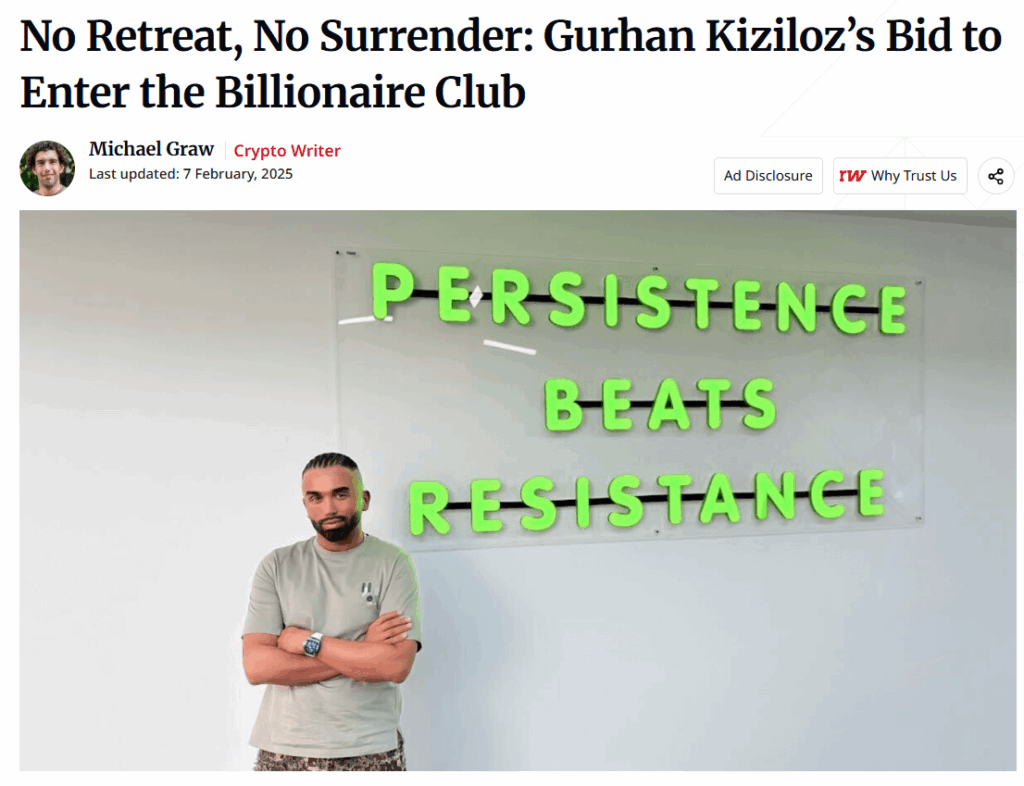Introduction: The Rise and Unease of a Self-Made Fintech Mogul
Gurhan Kiziloz is a name that has been echoing through the fintech corridors of the UK and beyond, often painted as a revolutionary entrepreneur reshaping how we perceive banking and digital finance. With a flashy style, bold declarations, and a social media presence filled with celebrities, luxury, and ambition, Kiziloz appears to embody the modern disruptor archetype. He claims a net worth of $700 million and now sets his sights on gaming, pivoting his company Nexus International into Brazil’s exploding iGaming market with Megaposta.
On paper, it’s a remarkable rags-to-riches story—an unorthodox founder shaking up traditional financial norms, ready to conquer new frontiers. But the glittering narrative begins to tarnish the moment you scratch the surface. Beneath the carefully crafted PR, there are mounting questions, legal entanglements, financial red flags, and growing consumer concerns.
This investigation into Gurhan Kiziloz, his companies (Lanistar, Nexus International, and Megaposta), and the growing web of inconsistencies surrounding him is not just an exposé—it’s a cautionary tale for investors, consumers, and regulators alike.

The Genesis of Lanistar: Flash Over Substance?
Founded in 2019, Lanistar burst onto the UK fintech scene with an aggressive marketing campaign powered by influencers and football stars. Its promise? To provide a multi-currency debit card with cutting-edge security and design, promising a revolution in digital payments. With endorsements from reality TV personalities like Amber Gill and footballers such as Kevin De Bruyne, Lanistar captured public imagination quickly.
Yet, from the beginning, skeptics questioned how such an untested fintech could achieve what it claimed. The UK’s Financial Conduct Authority (FCA) was among the first to raise eyebrows, issuing a warning in 2020 about Lanistar promoting financial services without proper authorization. Although the warning was later removed after the company allegedly addressed the issue, it highlighted a fundamental flaw: a focus on promotion over compliance.
To many, Lanistar looked more like a marketing company wrapped in fintech clothing—a startup that mastered influencer buzz but struggled with execution. Instead of building trust through transparency and regulatory compliance, Lanistar seemed to rely heavily on hype and visibility.
Lanistar’s Financial Troubles: A Startup in Freefall
By 2025, cracks in the empire became impossible to ignore. Two winding-up petitions were filed against Lanistar in less than six months—one tied to unpaid rent. While the company settled and avoided liquidation through last-minute payments, this pattern suggested a recurring liquidity crisis.
This was particularly damning for a company allegedly backed by millions. Where was the capital? Why couldn’t basic debts be settled on time? For a business that claimed to be scaling internationally, this kind of operational fragility raised serious alarms. Was the money tied up in marketing theatrics? Or worse—was it never there to begin with?
Such events raised the possibility that Lanistar was not just poorly managed, but that its entire financial footing was far weaker than claimed. The company’s financial statements remain unaudited and private—leaving the public to rely solely on self-published figures and unverifiable success metrics.

Gurhan Kiziloz: A Man of Many Claims but Few Proofs
Much of the mystique around Gurhan Kiziloz stems from his bold public persona. He describes himself as driven by ADHD—a trait he spins as a “superpower,” claiming it fuels his high-energy leadership and creative thinking. This has become part of his personal branding, as seen in interviews and puff pieces from partner media outlets like The Jerusalem Post and IBTimes UK.
But critics argue that Kiziloz’s flamboyant storytelling masks a fundamental lack of transparency. Despite claiming a net worth of $700 million and gunning for a $1 billion valuation, there is no independent verification—no entries in Forbes, no investor disclosures, no company filings to support these astronomical numbers. Notably, many articles covering Kiziloz appear to be sponsored or written “in cooperation” with his own PR team, raising doubts about their credibility.
This becomes even more concerning considering the companies he leads have minimal physical presence, unclear funding sources, and a worrying history of legal trouble and financial distress.
The Pivot to Gaming: A Diversion or Desperation?
In 2024, Gurhan Kiziloz announced that his attention had shifted from fintech to gaming. Lanistar faded into the background as Nexus International, a vaguely defined umbrella company, took center stage. Under Nexus, the new gaming brand Megaposta was launched, targeting Brazil’s rapidly growing online gaming market.
While the Brazilian gaming industry indeed offers enormous potential, Kiziloz’s sudden shift raised questions: Why pivot from fintech—his supposed area of expertise—into an unfamiliar and highly volatile domain? Was it a strategic move, or a way to escape the regulatory heat and financial collapse of Lanistar?
Moreover, Kiziloz has promoted the acquisition of a Brazilian gaming license, a claim echoed by various press releases. Yet again, there’s a lack of clarity. Is the license active or pending? PRNewswire described it as “pending final approval,” which hardly inspires confidence.
Without independent validation or operational data, Megaposta appears to be another shiny new venture filled with uncertainty. If the license fails or the market proves unstable, investors could find themselves trapped in yet another high-risk experiment driven more by ambition than sound planning.
Legal Troubles and Regulatory Red Flags
Throughout the rise of Gurhan Kiziloz, legal and regulatory issues have stalked his ventures. The most notable is the 2020 FCA warning, but even more concerning are the more recent winding-up petitions filed against Lanistar in 2025.
The financial instability and legal wrangling cast serious doubts on the long-term viability of Kiziloz’s ventures. Regulatory compliance is not optional in fintech or gaming—yet Kiziloz often treats it like a nuisance. For example, Lanistar failed to submit required annual accounts to Companies House for extended periods, risking dissolution. This pattern of noncompliance is not an oversight; it’s a symptom of a deeper cultural problem within the organizations he leads.
Meanwhile, consumer watchdogs have taken note. Independent review sites and social media threads host a growing number of complaints—from account issues with Lanistar to sluggish response times on Megaposta.
Negative User Reviews: Stories from the Ground
While mainstream media often avoids scrutiny of Gurhan Kiziloz, the voices of dissatisfied users reveal another side of the story. On social platforms like X (formerly Twitter), users have reported serious concerns:
Though scattered and not always documented in formal complaints, these stories paint a consistent picture: a consumer-facing brand struggling to meet basic service standards.
Worse yet, efforts to reach customer support often go unanswered—suggesting that these platforms may not have the staffing or infrastructure necessary to support a growing user base. This raises fundamental questions: if a company can’t even respond to users, how can it scale?
A Carefully Crafted PR Machine
If there’s one thing Gurhan Kiziloz excels at, it’s publicity. His team has mastered the art of media manipulation. Articles about him often appear in fringe business magazines, crypto news sites, or international media under unclear sponsorships. Outlets such as The Jerusalem Post and IBTimes UK have run glowing profiles, often disclosing that the article was “written in cooperation” with the subject.
This is not journalism—it’s advertising wrapped in the guise of legitimacy. The reliance on paid features rather than organic coverage suggests that Gurhan Kiziloz’s empire is more dependent on perception than performance. This media strategy creates a dangerous illusion of success and credibility, luring in unsuspecting consumers and investors.
he Risk to Investors and Consumers
Gurhan Kiziloz’s ventures may offer compelling stories and bold visions, but the underlying risks are too significant to ignore. Whether you’re a potential investor or a curious customer, the warning signs are overwhelming:
Unverified financial claims
Repeated legal issues and insolvency threats
Unclear licensing and compliance in gaming
Poor user experience and mounting complaints
PR-driven hype with minimal independent validation
This is not a stable empire. It’s a high-stakes house of cards built on vague promises, borrowed celebrity clout, and a relentless PR engine.
Conclusion: Visionary or Dangerous Showman?
Gurhan Kiziloz presents himself as a barrier-breaking innovator—a bold entrepreneur ready to reshape industries from fintech to gaming. But reality tells a far more complicated story. His companies have faced financial turmoil, legal troubles, and customer backlash. Meanwhile, he continues to paint a picture of unstoppable growth with no hard proof to back it up.
Until there is full transparency, independently audited financials, and regulatory clarity, Kiziloz remains a figure cloaked in ambiguity. For investors, customers, and the media, the best approach may be to apply the brakes and ask hard questions. Because when the hype fades, what remains may be far from golden.







